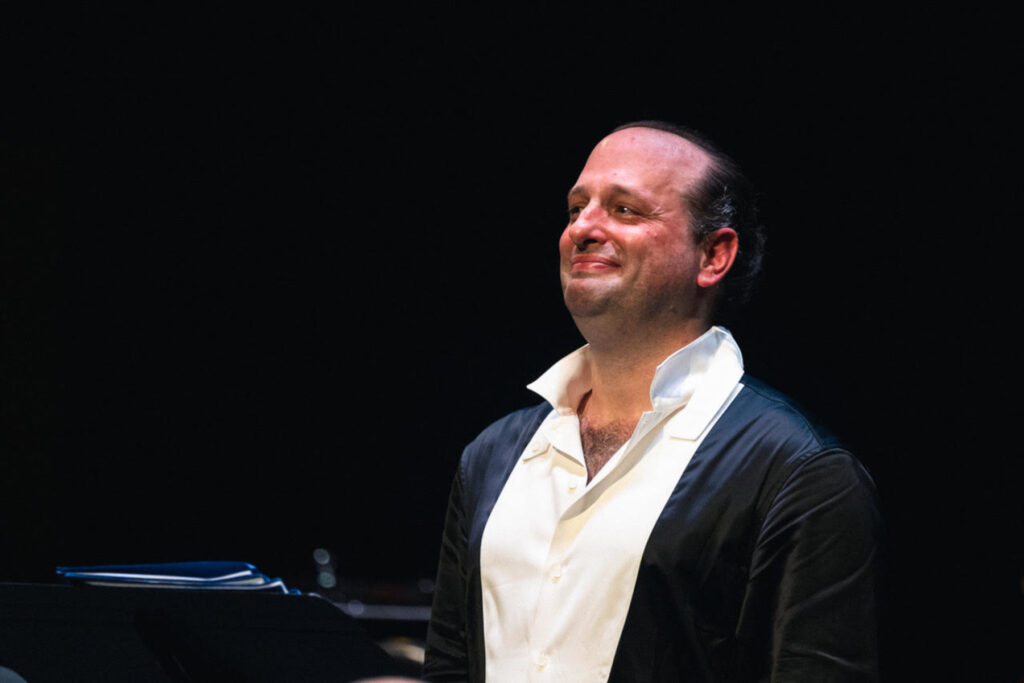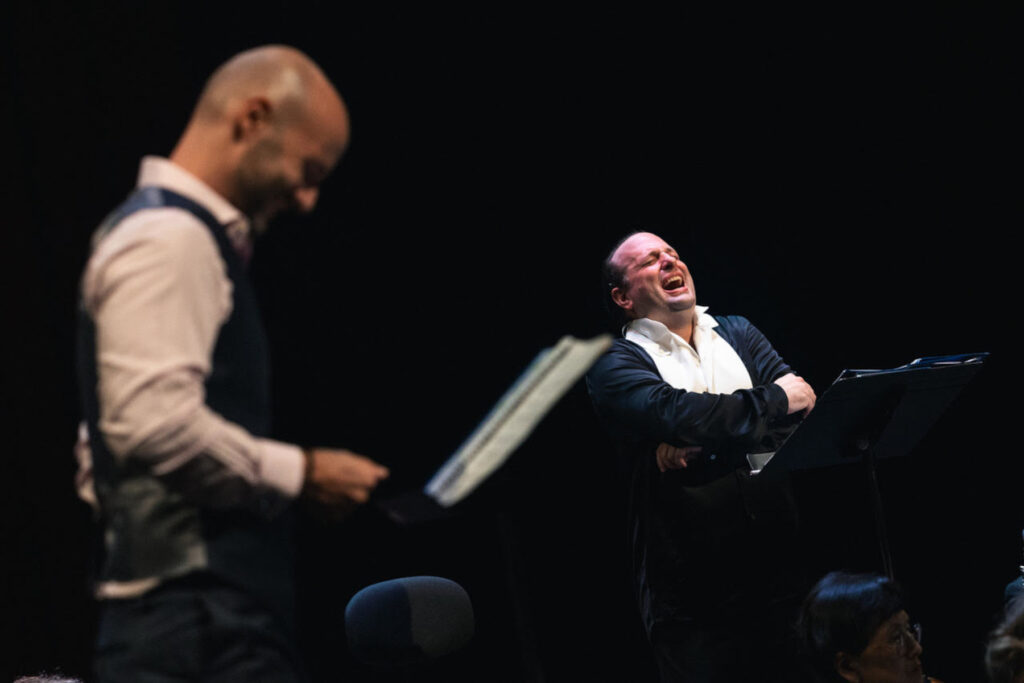The Festival Ravel, based in and around Saint-Jean-de-Luz – the delightful town on France’s Atlantic coast that neighbours Ravel’s birthplace Ciboure – was launched in its current form in 2021. Under the artistic direction of the pianist Bertrand Chamayou it has evolved to present an ambitious and imaginative 2025 edition. Running the gamut from solo recitals to orchestral concerts, and embracing electronic music, video installations and an academy for young musicians, it honours not only Ravel’s 150th anniversary, but also the centenaries of Erik Satie’s death and Pierre Boulez’s birth.
On 30th August it was the turn of opera: the premiere, in concert form, of La Main gauche. Drawing on events from the final decade of Ravel’s life, it is composed by Ramon Lazkano, who was born in 1968 and trained in his native Donostia-San Sebastián – some 30km west of Saint-Jean-de-Luz in the Spanish Basque Country – and at the Paris Conservatoire. The premiere formed the climax of a musical day that had started at 9 a.m. with the first of the prescribed 840 renditions of Satie’s enigmatic Vexations. Bertrand Chamayou himself led a relay team of pianists, each spending an hour or two at a Yamaha grand in a dank, cavernous space in the 17th century fortress that guards the bay of Saint-Jean-de-Luz. He was succeeded at the keyboard by Barbara Hannigan, who in the afternoon – and in her more familiar capacity as a soprano – joined him in Ciboure’s galleried, pagoda-steepled Church of Saint-Vincent for a performance of Satie’s Socrate. The duo favoured subtle expressivity rather than marmoreal formality in their approach to the three narrations that form the piece. The programme had opened with music written by Satie more than two decades earlier, in 1895, when he was not yet 30. He composed his Messe des pauvres for the independent ‘church’ he had founded, L’Église Métropolitaine d’Art de Jésus Conducteur, which reportedly never grew beyond two adherents – Satie and a friend. Austere, measured and ritualistic, if also not entirely devoid of sentiment, the mass featured the voices of eight singers from the Académie Ravel summer school, but over its 25-minute duration it was the organist Maude Gratton who assumed the lion’s share of responsibilities.

The indefatigable Chamayou made a further public appearance in the evening, hosting an introductory discussion on La Main gauche with Ramon Lazkano and Pierre Bleuse, chief conductor of the Ensemble Intercontemporain (founded 49 years ago by Pierre Boulez). Unfortunately, Jean Echenoz, the Prix Goncourt-winning author of the 2006 novel Ravel – Lazkano’s source for the libretto of La Main gauche – was prevented by personal circumstances from participating. Echenoz’s appropriately compact book covers the period from Ravel’s tour of the USA in 1928 to his death in 1937. As it progresses it homes in on the degenerative neurological condition that gradually compromised the composer’s faculties, finally rendering him unable to set down his thoughts, although, as he told a friend, “I have so much music in my head.”
During the discussion Chamayou reminded the audience that it was while bathing in the ocean at Saint-Jean-de-Luz in 1933 that Ravel suddenly found himself unable to swim. This incident is not portrayed in the course of Lazkano’s opera, which is divided into three parts and 15 scenes and runs for a little under 90 minutes. A musical analogue for the swimming crisis is the incident (Scene 9) when Ravel omits a substantial section of his Sonatine in a public performance. Caressing, but fragmented phrases from the familiar piano work surge and subside through Lazkano’s intricate instrumental textures – like Ravel, he is clearly a meticulous composer – in a way that is both touching and distressing. Lazkano says that the Concerto for the Left Hand, premiered in 1932 (and performed at this year’s Festival Ravel by Kirill Gerstein), underpins the entire opera. Paul Wittgenstein, who commissioned the concerto, even makes an appearance in Scene 8, in conversation with the French pianist Marguerite Long. That being said, overt musical references to the piece are rare, though the contrabassoon growls of its opening bars make a prominent appearance towards the end of the opera. In fact, throughout La Main gauche the obvious references to music by Ravel are more evocative for being fleeting. Lazkano’s score is in no way a pastiche and its uncompromising style suggests that he is more of a modernist than a post-modernist. While there is a tense pointillist finesse in much of the writing, when disaster really strikes Ravel, it finds expression in brutal musical terms that darken the opera’s mood and idiom irrevocably.

Under Pierre Bleuse’s baton, 14 instrumentalists from L’Ensemble Intercontemporain were supplemented by an accordionist; as Lazkano pointed out, the accordion does not appear in Ravel’s output, but here it placed a vague, unnerving haze on the aural picture. A lavish array of percussion instruments, assigned to a single, very busy player, took up a substantial portion of the stage in the auditorium of the Centre culturel Peyuco Duhart, a clean-lined space inaugurated just two years ago. The three singers spent most of the time confined to individual pedestals. The role of Ravel is assigned to a tenor, while a soprano and baritone take multiple roles as the people in Ravel’s life (whether friends or fellow artists, or professionals of other kinds, such as a ship’s captain or a surgeon) and also act as a narrating chorus. This is an opera that concisely signals and sketches characters and relationships rather than fleshing them out. Peter Tansits, a physically demonstrative performer and a gutsy singer (and, as was sometimes evident, not a native Francophone), was perhaps surprise casting as the famously fastidious Ravel, but the dislocation highlighted aspects of the composer that generally go relatively unobserved: passionate, defiant intensity is a defining feature of the Concerto for the Left Hand. The sumptuousness of Marie-Laure Garnier’s timbre was especially evident in in Lazkano’s melismatic writing for the flamboyant Ida Rubenstein (who throws in a reference to her tame leopard), while Allen Boxer (an American noted in France as an exponent of Debussy’s Golaud) brought gravitas, graphite-shaded tone and a quizzical air to his interventions.
La Main gauche, which receives its second performance on 3rd October, in semi-staged form at the Philharmonie de Paris might come as a surprise to anyone who has read Jean Echenoz’s novel, a lucid, precisely observed narrative told in sober, elegant prose. Lazkano’s opera is virtuosically complex in its form and textures, less intimate, more stylised, more challenging and ultimately more angry. By no means is it simply ‘the opera of the book’.
Yehuda Shapiro
La Main gauche (world premiere)
Music composed by Ramon Lazkano
Libretto by Ramon Lazkano, based on the novel Ravel by Jean Echenoz
Performers:
Peter Tansits – Ravel; Marie-Laure Garnier – various roles; Allen Boxer – various roles; Conductor – Pierre Bleuse; Ensemble Intercontemporain
Festival Ravel, Centre culturel Peyuco Duhart, Saint-Jean-de-Luz, 30 August 2025
The Festival Ravel runs until September 7th
All photos © Valentine Chauvin